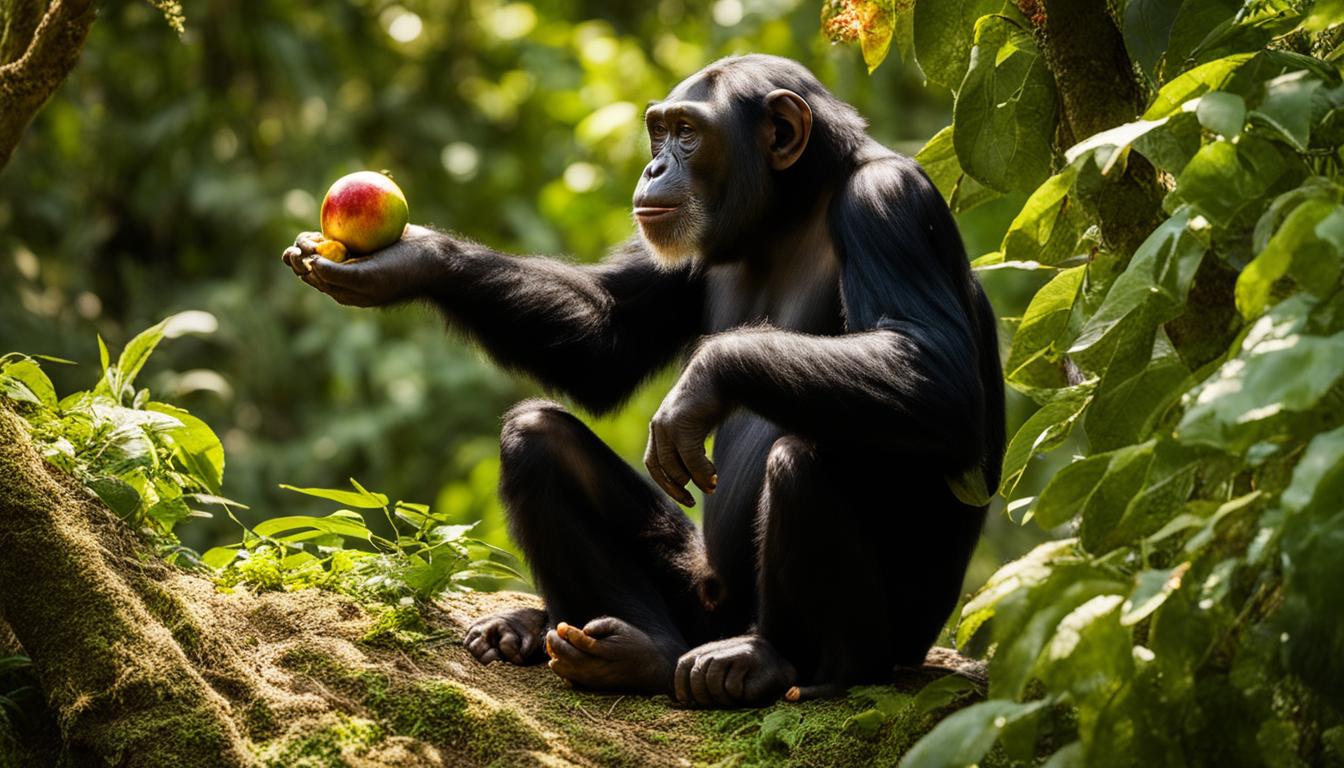Chimpanzees, our closest primate relatives, have a fascinating communication system that involves a combination of vocalizations, gestures, and facial expressions. They use approximately 2,000 unique gestures to convey messages and emotions, similar to the way humans use language. These gestures include hand movements, body postures, and facial expressions.
Chimpanzee communication follows linguistic rules, such as Zipf’s law of abbreviation and Menzerath’s law, which are also observed in human language. This suggests that the underpinnings of chimpanzee communication and human language follow the same basic mathematical principles.
In addition to gestures, chimpanzees rely heavily on vocalizations to communicate. They produce a range of vocalizations including grunts, hoots, screeches, and barks. Each vocalization serves a specific purpose, such as alerting others to the presence of food or signaling danger.
Nonverbal communication, such as postures, gestures, and facial expressions, also plays a significant role in chimpanzee communication. These nonverbal cues help convey messages, express emotions, and maintain social relationships within their groups.
Studying chimpanzee communication provides valuable insights into the origins and development of human language. By understanding how chimpanzees communicate, we can better appreciate the complexities of primate vocalizations and nonverbal communication.
The importance of gestures in chimpanzee communication
When it comes to communication, gestures play a vital role in the world of chimpanzees. These intelligent creatures rely heavily on gestures to convey messages and emotions within their social groups. Through a rich repertoire of unique gestures, chimpanzees are able to communicate a wide range of information to their fellow group members.
Chimpanzees use gestures such as waving their hand in a specific direction to indicate where another chimp should look, or holding out a begging hand for support. Each individual chimpanzee also has their own distinctive pant-hoot, allowing the caller to be identified with precision. By combining different gestures, chimpanzees can express their needs, intentions, and emotions in a nuanced and sophisticated manner.
Gestures in chimpanzee communication are not only essential for conveying information, but they also help in maintaining social bonds within the group. Through their gestures, chimpanzees establish and reinforce hierarchies, resolve conflicts, and display affiliative behaviors. These nonverbal cues play a crucial role in minimizing aggression and promoting cooperation among individuals.
The diversity of chimpanzee gestures
The range of gestures used by chimpanzees is truly remarkable. Researchers have documented approximately 2,000 unique gestures used by chimpanzees in the wild, highlighting the complexity and sophistication of their communication system. These gestures include not only hand gestures but also body postures and facial expressions. By combining different gestures, chimpanzees can convey specific messages and meanings, adapting their communication to different social contexts and individuals.
Understanding the importance of gestures in chimpanzee communication provides valuable insights into the complexity of ape communication. By studying how chimpanzees use gestures, researchers can gain a deeper understanding of the evolution of human language and the intricate ways in which communication systems have developed in primates.
| Gesture | Description |
|---|---|
| Hand Wave | Chimpanzee waves its hand in a specific direction, indicating where others should look. |
| Begging Hand | Chimpanzee extends its hand in a begging gesture, seeking support or attention. |
| Pant-Hoot | A distinctive vocalization accompanied by a series of panting sounds, allowing individual identification. |
| Clapping | Chimpanzee produces a clapping sound by striking its palms together, often signaling excitement or anticipation. |
These are just a few examples of the gestures used by chimpanzees. The diversity and complexity of their gestures highlight the remarkable abilities of these primates in communicating with one another.
As researchers continue to delve into the world of chimpanzee communication, the importance of gestures becomes increasingly apparent. These nonverbal cues not only facilitate effective communication but also provide insights into the rich social lives and cognitive abilities of our closest living relatives, the chimpanzees.
Vocalizations in Chimpanzee Communication
Chimpanzees, like humans, use vocalizations as an important aspect of their communication system. These vocalizations serve various purposes and play a significant role in conveying messages and expressing emotions within the chimpanzee social group. From grunts and hoots to screeches and barks, chimpanzees have a diverse repertoire of vocalizations that they utilize in different contexts.
Food calls are one common type of vocalization used by chimpanzees to alert others to the presence of food sources. These calls vary depending on the type of food and can help coordinate group feeding efforts. Additionally, chimpanzees emit loud, long “wraaaa” calls to signal something unusual or dangerous, serving as a warning to other group members. This highlights the importance of vocalizations in maintaining group cohesion and ensuring the safety of the individuals within the group.
The vocalizations of chimpanzees also reflect their emotional states. For example, chimpanzees engage in breathy laughter during play, which is a vocalization associated with positive emotions and enjoyment. On the other hand, cries of fear can be heard when chimpanzees perceive a threat or danger in their environment. These vocal expressions provide insight into the emotional lives of chimpanzees and further enhance their communication capabilities.
Vocalizations in Chimpanzee Communication
“Chimpanzees have a diverse and nuanced vocal repertoire that allows them to convey messages, coordinate group activities, and express emotions. Their vocalizations are an integral part of their communication system, enabling them to navigate their social world.”
In conclusion, vocalizations play a crucial role in chimpanzee communication. The diverse range of vocalizations allows chimpanzees to convey messages, express emotions, and coordinate their activities within the social group. Just like humans, chimpanzees use vocalizations to communicate and understand the world around them. Understanding chimpanzee vocalizations provides valuable insights into primate communication patterns and sheds light on the complexities of language development.
Nonverbal communication in chimpanzees
Nonverbal communication plays a significant role in chimpanzee communication. Postures, gestures, and facial expressions are used to convey messages and emotions within the social group. For example, when greeting a dominant individual or responding to an aggressive gesture, subordinate chimpanzees may approach with submissive signals such as crouching or holding out a hand, accompanied by pant-grunts or squeaks. The dominant individual may respond with gestures of reassurance, such as touching, kissing, or embracing the subordinate. These nonverbal cues help maintain social relationships and minimize conflict within the group.
The Importance of Body Language
Chimpanzees utilize a wide range of body language signals to communicate with one another. Through postures and gestures, they convey various messages, including dominance, submission, playfulness, and fear. These nonverbal cues are crucial for establishing and maintaining social hierarchies within chimpanzee groups. By accurately interpreting and responding to these signals, individuals can navigate their complex social dynamics and avoid confrontations. Through the use of body language, chimpanzees can communicate their intentions, emotions, and social status, fostering harmonious relationships within their groups.
The Role of Facial Expressions
Facial expressions are another essential component of chimpanzee communication. Like humans, chimpanzees use facial expressions to convey their emotions, intentions, and social signals. For example, a chimpanzee may display a relaxed, open-mouthed grin to convey friendliness and playfulness, while a bared-teeth display accompanied by aggressive body postures signifies a threat or dominance assertion. These facial expressions provide valuable insights into the emotional states of chimpanzees and help regulate social interactions within their groups. By interpreting and responding to facial expressions, individuals can navigate social situations and maintain cohesive group dynamics.
Understanding the intricacies of nonverbal communication in chimpanzees is vital for comprehending their social dynamics and overall behavior. Through the use of postures, gestures, and facial expressions, chimpanzees are able to convey messages, maintain social hierarchies, and establish harmonious relationships within their groups. By studying these communication patterns, researchers gain valuable insights into the complexities of primate communication and the similarities between chimpanzee and human communication systems.

| Nonverbal Communication Signals | Meaning |
|---|---|
| Crouching, holding out a hand | Submissive gesture |
| Touching, kissing, embracing | Gestures of reassurance |
| Relaxed, open-mouthed grin | Friendliness and playfulness |
| Bared-teeth display with aggressive body postures | Threat or dominance assertion |
Similarities between chimpanzee and human communication
When it comes to communication, chimpanzees and humans share more similarities than one might expect. Both species utilize a combination of gestures, facial expressions, and vocalizations to convey messages and express emotions. Just like humans, chimpanzees have a diverse repertoire of gestures that they use to communicate with their fellow group members. These gestures can range from simple hand movements to more complex body postures, allowing them to convey a wide range of information.
Researchers have discovered that chimpanzee gestures follow linguistic rules similar to those found in human language. For example, chimpanzee gestures adhere to Zipf’s law of abbreviation, which states that commonly used gestures tend to be shorter and simpler than less frequently used ones. This finding suggests that the underpinnings of communication systems in chimpanzees and humans are rooted in similar mathematical principles.
Vocalizations also play a crucial role in chimpanzee communication. Chimpanzees have a wide array of vocalizations, each serving a specific purpose. These vocalizations can range from food calls to alarm calls, helping chimpanzees convey important information to their group members. Similar to humans, chimpanzees can also express emotions through their vocalizations, such as laughter during play or cries of fear in response to a perceived threat.
Table: Comparison of Chimpanzee and Human Communication
| Aspect | Chimpanzee Communication | Human Communication |
|---|---|---|
| Gestures | Utilize a wide range of hand and body gestures | Use hand gestures and body language to convey messages |
| Facial Expressions | Use facial expressions to convey emotions and intentions | Reveal emotions and intentions through facial expressions |
| Vocalizations | Produce a variety of vocalizations for communication | Use spoken language for communication |
| Social Cognition | Demonstrate an understanding of social relationships | Have complex social awareness and understanding |
In addition to these similarities in communication methods, chimpanzees also exhibit a deep understanding of the social world around them, much like humans. They are able to navigate complex social dynamics, recognize individual identities, and engage in cooperative behaviors. This level of social cognition further emphasizes the similarities between chimpanzee and human communication patterns.
Studying chimpanzee communication not only provides valuable insights into primate communication patterns but also sheds light on the origins and development of human language. By uncovering the similarities between chimpanzee and human communication, researchers can gain a deeper understanding of the complexities of language and how it has evolved throughout our evolutionary history.
Conclusion
Chimpanzees have a fascinating and intricate communication system that encompasses various forms of expression. Through gestures, vocalizations, and nonverbal cues, these primates convey messages, share emotions, and navigate social dynamics within their groups. The study of chimpanzee communication provides valuable insights into primate communication patterns and sheds light on the origins and development of human language.
While chimpanzee communication methods differ from human language, they follow similar linguistic rules. Researchers have discovered that chimpanzee gestures align with human language principles, such as Zipf’s law of abbreviation. This finding suggests that the fundamental mathematical principles underlying communication systems are shared between chimpanzees and humans.
Understanding chimpanzee vocalizations, gestures, and nonverbal communication offers us a window into primate communication as a whole. By observing and studying the complex interactions of chimpanzees, we can deepen our knowledge of ape communication and gain a deeper understanding of our own communication patterns.
Primate communication patterns, including those of chimpanzees, are intricate and multifaceted. Through the exploration of their diverse communication system, we can gain insights into the complexities of primate social dynamics and the development of language across species.
Can Chimpanzees Use Non-Verbal Communication to Communicate with Each Other in the Wild?
Chimpanzee communication in the wild is largely non-verbal, consisting of gestures, facial expressions, and body language. This form of communication allows chimps to convey information about food sources, danger, and social dynamics. Through these non-verbal cues, chimpanzees can effectively communicate with each other in their natural habitat.
FAQ
How do chimpanzees communicate with each other in the wild?
Chimpanzees use a combination of vocalizations, gestures, and facial expressions to communicate with each other in the wild.
What types of gestures do chimpanzees use to communicate?
Chimpanzees use approximately 2,000 unique gestures, including hand gestures, body postures, and facial expressions, to convey messages and emotions.
How do chimpanzees use vocalizations to communicate?
Chimpanzees use a repertoire of vocalizations, such as grunts, hoots, screeches, and barks, to communicate various messages and emotions to each other.
How do chimpanzees communicate nonverbally?
Chimpanzees use postures, gestures, and facial expressions to convey messages and emotions within their social group.
What are the similarities between chimpanzee and human communication?
Chimpanzees and humans both use a combination of gestures, facial expressions, and vocalizations to convey messages and express emotions. The underpinnings of communication in both species follow similar mathematical principles.
What can studying chimpanzee communication teach us about primate communication patterns?
Studying chimpanzee communication can provide valuable insights into the origins and development of human language and help us better understand the complexities of primate communication patterns.










